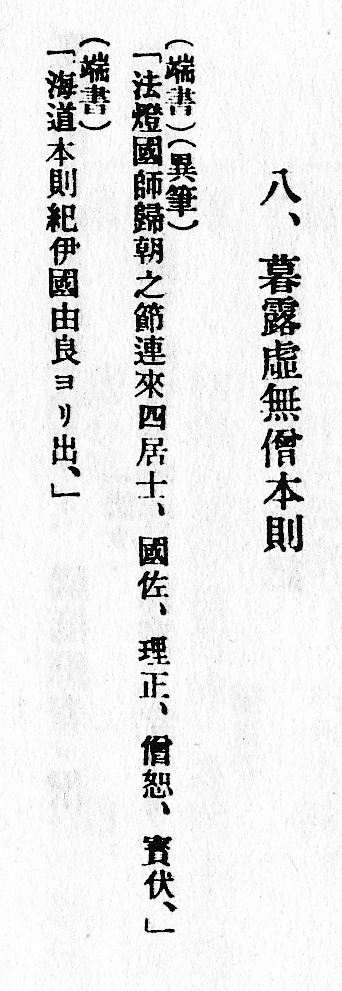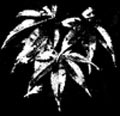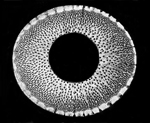|
1640-1646: The Hottō Kokushi/Kakushin Fully Fabricated Fable:
The "Four Buddhist Laymen" & the "Disciple" 'Kichiku'
The renowned, former Shingon monk and later Zen abbot Shinchi Kakushin who lived from 1207 to 1298 did not transmit
any Chinese "Zen Shakuhachi" tradition to Japan when, in 1254, he repatriated from four years of studying Zen Buddhism in China.
Nowhere in the numerous preserved writings by Kakushin himself, published in full in reprint by his own temple:
the Kōkoku-ji in Yura, Wakayama Prefecture, in 1938 and 1981 - nor anywhere else in contemporary sources -
do we encounter any proof whatsoever of such beliefs, be these even wholehearted claims.
It was only as late as after the very dramatic Christian uprising, the Shimabara Rebellion, near Nagasaki in 1637-38 and the following introduction in 1640 of strict
'shūmon aratame' population registration by the government and the Buddhist temples that the 'miyogiri'-playing mendicant masterless samurai
so far known as 'komosō' ("mat monks") appear to have realized an a somehow urgent necessity to reorganize and re-identify themselves as 'komusō',
"lay monks of non-duality and none-ness".
We know well from the 1628 document Kaidō honsoku that the 'komosō' did not at all recognize any "history", no lineages,
no ancient founders nor transmitters of their tradition. They only admired the Chinese monk Fuke as some kind of an idol, a source of ideological inspiration, so to speak.
However now, during the early 1640s, members of a partly new generation (!) of that "mat monk fraternity" appear to have consulted and inquired with
the prominent Buddhist clergy regarding what to do, seriously, in order to create a new image for themselves, a much more respectable identity and more secure survival
possibilities, in the capacity as devoted Buddhist practitioners and - first of all: Not at all suspicion-causing,
secret Christian converts and thus potential traitors to the new Tokugawa régime.
1645-46:
ABBOT ISSHI's LETTER to the KOMUSŌ and HERMIT SANDŌ MUGETSU
The oldest surviving textual evidence of the creation of a "Kakushin Legend", a name for a new "sect", namely 'Komu shizen',
虚無自然,
and the appellation 'komusō' was composed by a very close disciple and friend of the famous Takuan Sōhō (1573-1645).
That prominent student's name is Isshi Bunshu; he lived from 1608 to 1645 (or 1646).
In Isshi's letter, composed in pure 'kanbun' (pseudo-Chinese) style, we read as follows,
"In China there was Fuke; [as for] my [own] country itself, how possibly could Hottō Kokushi accomplish as the originator of the congregation?
When Kokushi was in China, one after the other four K(y)omu persons joined him and, succesfully, came [with Kokushi] to this country.
Later, the paths [lit.: "branch veins"] of these honorary men separated into four, respectively [thus totalling 16], and - travelling in all directions -
wherever they came they brought relief to the Buddhist community."
Here is a digitalization of the original Japanese wording, written in pure 'kanbun' literary style:
支那有普化、我朝自, 法燈國師會裡得始祖如何、
國師入唐時,虚無四人各従國師而得々來本朝,
(然)後彼四老之派脉分、作四爾來洋々乎、偏扶桑國、
Translation by Torsten Olafsson.
Late 1640s?:
KAIDŌ HONSOKU document of 1628 - the "Version 3" Copy:
A short sentence, or headline, is added at the top (of a copy?) of that document.
In 1938, Hottō Kokushi's temple Kōkoku-ji in Yura, Wakayama Pref. south of Kyōto, published a complete reprint collection of that temple's preserved documents
in a fine book entitled Shūhō Yokō, "Lingering Light over the Eagle Peak".
In that book, on page 72 in Part 2, where the headline of the Kaidō honsoku is reprinted, the editor, Mori Hikotarō, added this note of comment:
'i-hitsu', 異筆, "different brush/style of writing" right next to this, the very first sentence in the reprinted text:
"When Hottō Kokushi returned to his native country, he was accompanied by four Buddhist laymen: Kuo Tsuo, Li Cheng, Tseng Shu & Pao P'u
[in Japanese: Kokusa(ku), Risei, Sōjo and Hōfu]."
法燈国師帰朝之節連来四居士、國佐、理正、僧恕、寶伏。
Here, "written differently" can only mean that that very sentence about Hottō Kokushi and his legendary four Chinese disciples must have been added to the
document scroll considerably later than 1628, and - furthermore - at a time when the four disciples had also been given actual personal names.

Scanning of the above mentioned source collection page
Translation by Torsten Olafsson, 1986.
1664
SHICHIKU SHOSHINSHŪ by Nakamura Sōsan
虚無僧尺八というは
長さ一尺八寸に切ゆえ尺八というとぞ、
濫觴はたしかに不知、
そのかみ由良の法燈此道の祖たるよしいへども
了簡せず。
"The komusō shakuhachi is named 'shakuhachi' because its length has been cut to the measure of 1 foot and 8 inches.
Its origin is certainly unknown.
Although it is being said that Hottō of Yura [Shinchi Kakushin] was the founder [of the komusō], that I do not ascertain. - - - "
Translation by Torsten Olafsson.
c. 1665-1675?
KYOTAKU DENKI by Ton'o (?)
学心学之有日、禅已熟、曲已就、
而告別干張参辞舒州、
而解纜干明州、南宋理宗宝帝祐二年、帰船干本邦。
"Gakushin [i.e.: Kakushin, alias Hottō Kokushi] studied the art of the kyotaku. As the days passed, he went to the heart of Zen philosophy
and attained proficiency in the kyotaku;
finally he took leave of San [Kakushin's alleged kyotaku teacher Chōsan] (to return to Japan).
Gakushin left Hsü-Chow for Ming-Chow, where he unmoored his ship.
It was in the second year of the Sung Dynasty that he returned to Japan, where it was the sixth year of Kenchō,
in the the reign of Emperor Gofukakasu."
自是学心、或高野山入、或出洛陽城、
逍遊有年、造立一寺干紀州、号西方寺、
而終住干此。
"Thereafter, Gakushin confined himself in a mountain temple at Kōyasan, sometimes visiting the capital (Kyoto).
Years passed, and he founded a Buddhist temple named Saihōji in the province of Kishū [present-day Kōkoku-ji in Wakayama Pref.],
where he established his permanent abode.
- - -
徒中有寄竹者、以禅心殊切、敬師益甚、
学心亦親眤之異干他弟子、
一時学心告之、
"Among his numerous students, there was one called Kichiku.
The more earnest he became in his devotion to Zen Buddhism,
the more ardent was his admiration for his master.
Gakushin also took a more kindly interest in him than in other students.
One day Gakushin told Kichiku:"
以在宋之時伝 得虚鐸音今尚能調之、
且謂、欲長授干汝面嗣此之伝、
寄竹踊躍拝謝、伝此之音、熟習嗜寿日不置。
"'When I was (studying) in the country of Sung, I was instructed in the kyotaku and I perform on it well even today.
I would like to initiate you in this flute in the hope that, as my successor, you will pass this art on to posterity.'
Kichiku, dancing for joy and expressing his gratitude, received instruction in this music and attained proficiency in the instrument.
He took delight in playing it everyday untiringly."
他弟子、国作、理正、法普、宗恕、
四人亦能学此管、世称四居士。
"There were four more students - - Kokusaku, Risei, Hōfu and Sōjo - - who also learned this flute well.
They were known to the world under the (collective) title Shikoji ("Four Devoted Men")."
- - -
Quoted from the 'Kyotaku denki', trsl. by Tsuge Gen'ichi, 1977.
Printed in Asian Music, Vol. VIII, 2. New York, 1977.
1735
KYOREI-ZAN ENGI NARABI-NI SANKYOREI-FU BEN by Kandō Ichiyū
- - -
Par. 2:
興国開山法灯国師入宋帰国之日、
宋地、国作、宋恕、理正、法普
之四居士随待来干我邦、
皆是風顛漢、而以普化為祖、以尺八為法器、
幽柄鷲峰 谷、尋常弄尺八為遊戯三味、
共旧跡干今号普化谷。
"The founder of the Kōkoku (Temple), Hottō Kokushi, travelled to Sung (China), and on the day of his return (to Japan),
four Buddhist laymen of Chinese descent, namely Kokusa(ku), Sōjo, Risei and Hōfu, accompanied him to our country.
They were all highly cultured Chinese and with Fuke as their role model [lit. ancestor] and the shakuhachi as implement of the Buddhist Law [hōki],
confining [or, secluding] themselves in the valley beneath the Eagle Peak [the mountain where Kōkoku-ji is located],
they used to take pleasure in playing the shakuhachi as a way of practicing meditation [sammai].
Today, the site of their old common dwelling place [kyūseki] is called "The Valley of Fuke"."
Par. 4:
虚竹有投機偈伝、
一従載断両頭後、
尺八寸中通古今、
吹起無生真一曲、
三千里外絶知音、
"Kyochiku had [or, favoured] a speculative Buddhist verse,
which says,
'When one has cut off Dualism,
the essence of the shakuhassun
transcends Past and Present.
That one sound blowing forth
of the True Reality of the Non-born
exceeds the deepest of friendships,
beyond limit.'"
Par. 5:
嘗虚竹在城州宇治、号朗菴主、
命終樹塔於宇治郡五筒庄中、
人呼為普化塚也。
"Once Kyochiku stayed in Uji in Jōshū [mod. Kyōto Prefecture] he called himself 'Rōan the Hermit'.
By the end of his life he erected a five-levelled monument
[a 'gorintō' grave pagoda?] in the vicinity of Uji.
People call it 'The Grave of Fuke'."
Par. 6:
至於第二世明普、居干洛東、
建立虚霊山明暗寺、
於今普化一流相承来也、
"As for Kyochiku's successor Myōfu, when he lived in the East of the capital [Kyōto Higashiyama],
he established [lit.: build] the Empty Spirit Mountain Myōan Temple,
and so the School [Jap.: 'ichi-ryū'] of Fuke has been preserved till today."
- - -
Translation by Torsten Olafsson.
1795
KYOTAKU DENKI KOKUJIKAI edited by Yamamoto Morihide
The original text of the 'Kyotaku denki' document is eventually published, in Kyōto.
1816
Miyaji Ikkan's SHAKUHACHI HIKKI
一書ニ云
後深草院建長六年八月二日法燈国師同船ニテ、
四居士来朝ス。
宝伏居士宋怒居士ハ鎮州ノ人。
国佐居士ハ齋州ノ人。
理正居士ハ幽州ノ人。
又云四居士来朝シテ、興国寺ノ廣化庵ニ住テ、我宗ヲ(?)ム。
四居士各四弟子アリ。
都合十六弟子。
正法ヲ附与ス。
仍テ十六派ニ分ル。
今七派相續九派断絶。
"It says in a book, that during the reign of Emperor Go-Fukakusa, on the 2nd day of the 8th month in the 6th year of the Kenchō Period [1254],
onboard the same ship as Hottō Kokushi there were four Buddhist laymen who came to this country.
The Buddhist laymen Hōfu and Sōjo were men from the Chin Province.
Buddhist layman Kokusa was a man from the Sai Province.
Buddhist layman Risei was a man from the Yū Province.
It also says [in the book] that when the four Buddhist laymen had come to this country they settled to live in the Kōke Hermitage of the Kōkoku Temple,
and then they founded [?] our sect.
The four Buddhist laymen each had four disciples. A total of 16 disciples.
They established the True Teaching [of my/our sect].
Therefore they divided [and organized the sect] into 16 branch sects.
Seven factions have been continued, nine factions have become extinct."
古十六派 - KO-JŪROKU-HA
古十六派ト云ハ - "The old 16 factions were called:
靳詮 改今ノ金先派 - Kinzen, changed to the pres. Kinsen-ha
宋和 今ノ根笹派 - Sōwa - the present Nezasa-ha
火下 今ノ活惣派 - Kaka - the present Kassō-ha
寄竹 - Yoritake/Kichiku
梅土 - Umeji
小菊 - Kogiku
夏潭 今ノ不智派 - Katan - the present Fuchi-ha
右七派相続ス
The above 7 branch sects are continued/are still in existence.
養沢 - Yōtaku
義文 大櫻トモ - Gibun - also called Dai-ō [?]
司祖 - Tsukasaso/Shiso
短尺 多門トモ - Tanjaku - also called Tamon
野木 - Noki/Nogi
芝隣 酒林トモ - Shirin - also called Sakabayashi
陰巴 - Indomoe/Inpa
雄南 野ノ派トモ - Yūnan - also called No no ha
児派 - Chigo
右九派断絶ス
The above 9 branch sects are extinct/discontinued."
Translation by Torsten Olafsson.
1899
Edmond Papinot & Terence Barrow: A Geographical Dictionary of Japan (translated from the French by Terence Barrow)
"Fuke-shū, 普化宗.
A branch of the Zen sect, founded by the Chinese bonze Fuke-Zenji.
In 1248, the bonze Kakushin went to China, where the famous Busshō-Zenji of the Gokoku-ji temple taught him the doctrines of the sect.
There was a certain Chōyū in the temple who was very skilful in playing the flute (shakuhachi) and from him Kakushin received lessons.
After his return to Japan (1254), he went through the country preaching and playing the flute.
His successors Kichiku and Komu did likewise, and the name of the latter, Komu-sō has become the generic name by which
travelling bonzes of the sect were designated.
Under the Tokugawa, many samurai without masters enrolled in the Fuke-shū sect, dressed in the traditional costume and wore large hats
so as to hide their faces.
They went through the country begging and playing the flute.
To avoid justice or the supervision of the shogunate, it became customary to become a Komusō;
but disorders having ensued, Ieyasu published a regulation to fix their privileges and their obligations.
The sect has seventy-three temples, all depending on Ichigetsu-ji at Koganei (Shimōsa).
It was interdicted at the Restoration."
Translated from the French by Terence Barrow, first published in 1910.
|

Momiji
|


